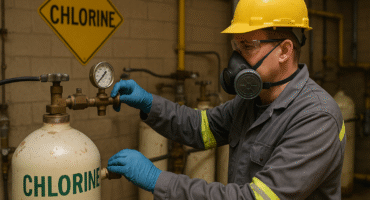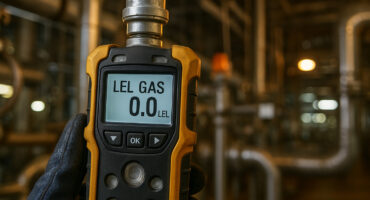In industrial environments where flammable gases are present, the risk of gas leaks and explosions is a constant concern. Detecting these gases before they reach dangerous concentrations is crucial for ensuring the safety of workers and the protection of equipment.
One of the most effective ways to monitor gas levels is through the use of LEL (Lower Explosive Limit) sensors. These devices are designed to detect the concentration of flammable gases in the air, providing real-time measurements that help prevent potentially catastrophic incidents.
The Lower Explosive Limit (LEL) is the minimum concentration of a flammable gas in the air that can ignite when exposed to a source of ignition.
Each flammable gas has a specific LEL, and when the concentration of the gas in the air is below this threshold, it is too lean to burn. However, once the LEL is reached or exceeded, there is a serious risk of explosion or fire.
Monitoring gas concentrations and maintaining them well below the LEL is vital for preventing accidents in environments where combustible gases are present. Failure to control gas levels can lead to devastating explosions, putting lives, equipment, and infrastructure at risk. This is why reliable gas detection systems, including LEL sensors, are critical components of safety protocols in industries such as oil and gas, manufacturing, and chemical processing.
LEL is measured using sensors specifically designed to detect the concentration of flammable gases in the air. These sensors continuously monitor the environment, providing real-time data that ensures gas levels remain below the explosive threshold.
In practical terms, when the concentration of gas approaches dangerous levels, the sensor triggers alarms and alerts, allowing workers to take immediate action to prevent potential incidents.
The importance of using LEL sensors lies in their ability to provide precise measurements, even in complex industrial environments. Although this article does not delve into the technical workings of sensors, it is essential to know that they are a key tool in ensuring safety.
Please refer to the LEL Sensor Table at the end of this article for a detailed overview of the explosive limits of common gases, providing important reference points for safe gas detection.
An LEL sensor is a device used to detect and measure the concentration of flammable gases in the air. These sensors play a vital role in industries where gas leaks could lead to catastrophic explosions.
By continuously monitoring the environment, LEL sensors ensure that gas levels stay below the lower explosive limit, providing early warnings and allowing preventive measures to be taken before a critical situation develops.
There are three main types of LEL sensors, each with its own strengths and weaknesses: Catalytic sensors, Infrared (IR) LED sensors, and MPS (Molecular Property Spectrometer) sensors. Understanding the differences between these types helps determine which sensor is best suited for a particular application.
Catalytic sensors are widely used for detecting flammable gases, including hydrogen, through a combustion process within the sensor.
Advantages:
Limitations:
Infrared LED sensors operate using light absorption techniques to detect gas concentrations, offering several advantages over catalytic sensors.
Advantages:
Limitations:
The MPS sensor is an advanced type of LEL sensor that offers some of the most sophisticated gas detection capabilities available.
Advantages:
Drawbacks:
When it comes to ensuring safety in environments where flammable gases are present, maintaining gas concentrations below the Lower Explosive Limit (LEL) is essential.
The general rule is that any concentration below 100% of the LEL is considered safe for working conditions. However, the closer the concentration gets to 100%, the more hazardous the situation becomes.
A safe working environment is typically one where gas concentrations are far below the LEL threshold. Although some gas may be present, workers should never assume it is safe to continue operations if levels are close to or exceed the LEL. The purpose of an LEL sensor is to provide early warnings, allowing proactive measures to be taken before the situation escalates to dangerous levels.
For many gases, concentrations between 0-10% of the LEL may be considered safe, but once concentrations approach 20-25%, it is imperative to take precautions. At 100% LEL, any ignition source can cause an explosion.
| Gas | LEL | UEL |
| Acetone | 2.6 | 13.0 |
| Acetylene | 2.5 | 100.0 |
| Acrylonitrile | 3.0 | 17.0 |
| Allene | 1.5 | 11.5 |
| Ammonia | 15.0 | 28.0 |
| Benzene | 1.3 | 7.9 |
| 1,3-Butadiene | 2.0 | 12.0 |
| Butane | 1.8 | 8.4 |
| n-Butanol | 1.7 | 12.0 |
| 1-Butene | 1.6 | 10.0 |
| Cis-2-Butene | 1.7 | 9.7 |
| Trans-2-Butene | 1.7 | 9.7 |
| Butyl Acetate | 1.4 | 8.0 |
| Carbon Monoxide | 12.5 | 74.0 |
| Carbonyl Sulfide | 12.0 | 29.0 |
| Chlorotrifluoroethylene | 8.4 | 38.7 |
| Cumene | 0.9 | 6.5 |
| Cyanogen | 6.6 | 32.0 |
| Cyclohexane | 1.3 | 7.8 |
| Cyclopropane | 2.4 | 10.4 |
| Deuterium | 4.9 | 75.0 |
| Diborane | 0.8 | 88.0 |
| Dichlorosilane | 4.1 | 98.8 |
| Diethylbenzene | 0.8 | 8.0 |
| 1,1-Difluoro-1-Chloroethane | 9.0 | 14.8 |
| 1,1-Difluoroethane | 5.1 | 17.1 |
| 1,1-Difluoroethylene | 5.5 | 21.3 |
| Dimethylamine | 2.8 | 14.8 |
| Dimethyl Ether | 3.4 | 27.0 |
| 2,2-Dimethylpropane | 1.4 | 7.5 |
| Ethane | 3.0 | 12.4 |
| Ethanol | 3.3 | 19.0 |
| Ethyl Acetate | 2.2 | 11.0 |
| Ethyl Benzene | 1.0 | 6.7 |
| Ethyl Chloride | 3.8 | 15.4 |
| Ethylene | 2.7 | 36.0 |
| Ethylene Oxide | 3.6 | 100.0 |
| Gasoline | 1.2 | 7.1 |
| Gas | LEL | UEL |
| Heptane | 1.1 | 6.7 |
| Hexane | 1.2 | 7.4 |
| Hydrogen | 4.0 | 75.0 |
| Hydrogen Cyanide | 5.6 | 40.0 |
| Hydrogen Sulfide | 4.0 | 44.0 |
| Isobutane | 1.8 | 8.4 |
| Isobutylene | 1.8 | 9.6 |
| Isopropanol | 2.2 | 12.0 |
| Methane | 5.0 | 15.0 |
| Methanol | 6.7 | 36.0 |
| Methylacetylene | 1.7 | 11.7 |
| Methyl Bromide | 10.0 | 15.0 |
| 3-Methyl-1-Butene | 1.5 | 9.1 |
| Methyl Cellosolve | 2.5 | 20.0 |
| Methyl Chloride | 7.0 | 17.4 |
| Methyl Ethyl Ketone | 1.9 | 10.0 |
| Methyl Mercaptan | 3.9 | 21.8 |
| Methyl Vinyl Ether | 2.6 | 39.0 |
| Monoethylamine | 3.5 | 14.0 |
| Monomethylamine | 4.9 | 20.7 |
| Nickel Carbonyl | 2.0 | 5.0 |
| Pentane | 1.4 | 7.8 |
| Picoline | 1.4 | 8.0 |
| Propane | 2.1 | 9.5 |
| Propylene | 2.4 | 11.0 |
| Propylene Oxide | 2.8 | 37.0 |
| Styrene | 1.1 | 6.8 |
| Tetrafluoroethylene | 4.0 | 43.0 |
| Tetrahydrofuran | 2.0 | 5.3 |
| Toluene | 1.2 | 7.1 |
| Trichloroethylene | 12.0 | 40.0 |
| Trimethylamine | 2.0 | 12.0 |
| Turpentine | 0.7 | 6.0 |
| Vinyl Acetate | 2.6 | 5.0 |
| Vinyl Bromide | 9.0 | 14.0 |
| Vinyl Chloride | 4.0 | 22.0 |
| Vinyl Fluoride | 2.6 | 21.7 |
| Xylene | 1.1 | 6.6 |
LEL sensors are crucial in providing real-time data to ensure that gas concentrations remain within safe limits. These sensors should be integrated into a broader safety system that includes alarms and emergency procedures for immediate evacuation or mitigation efforts if dangerous gas levels are detected.
Gas leak detection is an essential safety measure in industries where flammable gases pose significant risks. LEL sensors serve as a frontline defence, continuously monitoring gas concentrations and alerting workers before levels become hazardous.
By understanding the different types of LEL sensors—catalytic, infrared (IR) LED, and MPS sensors—organisations can select the most appropriate sensor for their specific environment and needs.
Each sensor type comes with its own advantages and limitations, from the affordability and broad detection capabilities of catalytic sensors to the advanced functionality and durability of MPS sensors.
Whichever sensor is chosen, ensuring that it is properly maintained and integrated into a comprehensive safety protocol is crucial for safeguarding both personnel and equipment.
By leveraging the power of LEL sensors, organisations can take proactive steps to prevent explosions, mitigate risks, and protect their workers, maintaining a safe and efficient working environment.
From the Blog



If you have any questions about our products or services, please feel free to contact us.